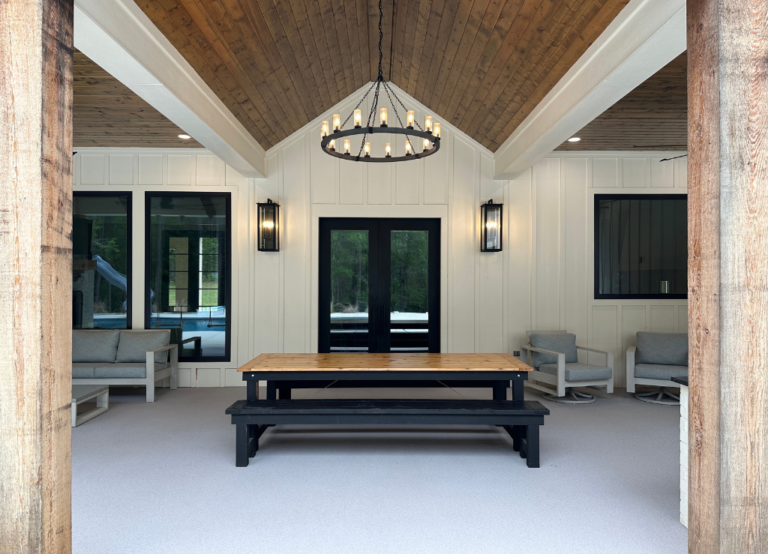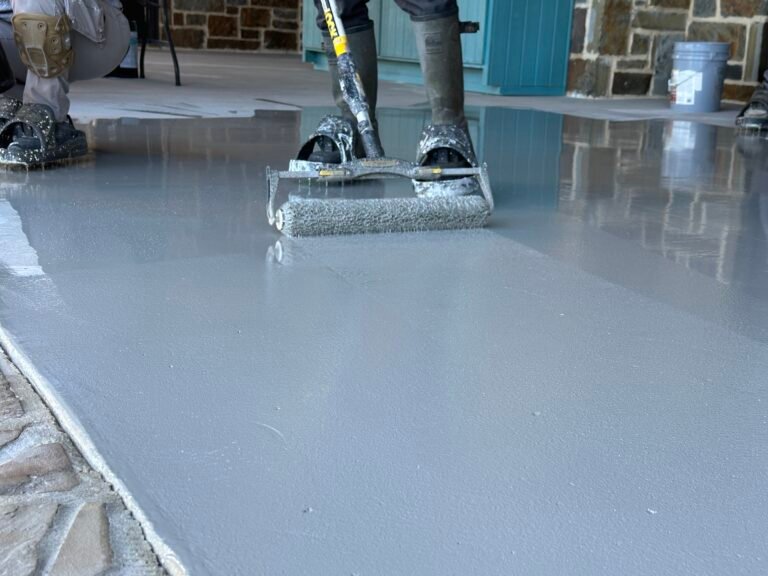Comparing the Options for Refinishing Your Patio
An East Texas patio can be a peaceful place for morning coffee or late-night gatherings. But if your concrete surface is cracked, stained, or just plain boring, you might be researching “epoxy” or other coatings. Let’s compare various popular refinishing options – epoxy, acrylic, stamped overlays, and polyaspartic – in a direct pros vs. cons format. By the end, you’ll see why so many local homeowners prefer polyaspartic with a quartz or flake broadcast to keep their patios both stylish and durable.
Epoxy Coatings
- Pros:
- Time-tested resin known for chemical resistance and glossy finishes.
- Widely available and relatively budget-friendly for smaller patio areas.
- Cons:
- UV Sensitivity: Strong Texas sun can cause yellowing and chalking.
- Long Cure: You might wait multiple days before heavy furniture placement.
- Moisture Issues: If your patio is partially uncovered, frequent rain or humidity can lead to peeling.
Verdict: Epoxy can work indoors or in fully shaded patios but struggles under direct sunlight and East Texas humidity.
Acrylic Sealers & Stains
- Pros:
- Inexpensive option that penetrates the surface, adding some color and sheen.
- Often “DIY-friendly” with quick dry times.
- Cons:
- Thin protective layer means minimal abrasion resistance.
- May require annual reapplication, especially in high-traffic or rainy conditions.
- Limited slip resistance unless additional additives are used.
Verdict: If you need a short-term fix or purely aesthetic upgrade for a seldom-used patio, acrylic might suffice, but it won’t stand up to heavy usage or direct sun for long.
Stamped Concrete Overlays
- Pros:
- Mimics stone, brick, or slate with decorative patterns, enhancing your patio’s look.
- Can handle moderate foot traffic if installed properly.
- Cons:
- Susceptible to chipping or spalling if moisture seeps under the overlay.
- UV exposure can fade certain color treatments, requiring resealing for color longevity.
- More expensive than basic acrylic, and still not as robust as polyaspartic.
Verdict: Stamped overlays achieve a high-end aesthetic but might need frequent sealing and careful maintenance in East Texas weather.
Polyaspartic (Flake or Quartz)
- Pros:
- UV-Stable: Maintains color under direct sun—crucial for open patios.
- Moisture Tolerant: With proper prep, it’s more forgiving of humidity or occasional rain.
- Decorative Possibilities: Flake finishes or quartz broadcasts can match your home’s exterior or landscaping.
- Quick Cure: Often walkable in hours, fully set for furniture in about 48 hours.
- Cons:
- Higher initial cost than acrylic or basic epoxy.
- Rapid cure demands professional installation to ensure a smooth, even finish.
Verdict: If longevity, slip resistance, and color stability rank high, polyaspartic outperforms the alternatives—especially in sun-exposed East Texas patios.
Key Comparisons
- UV Resistance: Epoxy falls short, acrylic can fade, stamped overlays need resealing, while polyaspartic remains stable for the long haul.
- Slip Resistance: Acrylic or stamped finishes may be slick without additives. Polyaspartic floors can incorporate quartz or flake for texture.
- Maintenance: Epoxy might need re-coats if yellowing occurs; acrylic must be resealed; stamped concrete can chip; polyaspartic typically requires a simple sweep or rinse.
When refinishing your patio in East Texas, weigh each option’s long-term resilience against local challenges – intense sunlight, humidity, and possible temperature swings. Though epoxy, acrylic, and stamped overlays each bring certain perks, polyaspartic emerges as the comprehensive solution for a patio that stays vibrant, slip-resistant, and virtually maintenance-free.
Ready to transform your outdoor living space? Contact Epoxy Coat Masters. We’ll walk you through how a polyaspartic system with flake or quartz can give your patio the color, texture, and durability you’ve been looking for – no constant re-sealing required.







